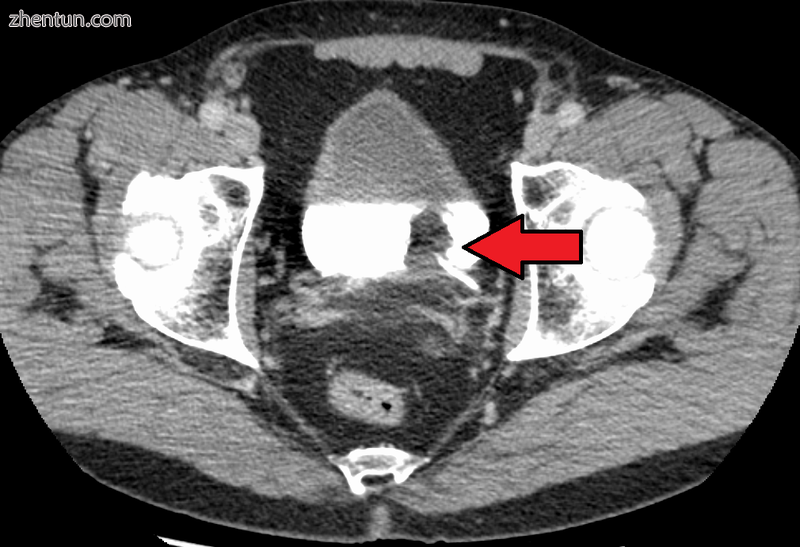
膀胱移行细胞癌。膀胱中的白色是对比。
膀胱癌是由膀胱组织引起的几种癌症中的任何一种。[1]它是一种细胞异常生长并有可能扩散到身体其他部位的疾病。[7] [8]症状包括尿液中的血液,排尿疼痛和腰痛。[1]
膀胱癌的危险因素包括吸烟,家族史,既往放射治疗,频繁的膀胱感染以及接触某些化学物质。[1]最常见的类型是移行细胞癌。[3]其他类型包括鳞状细胞癌和腺癌。[3]诊断通常通过膀胱镜检查进行组织活检。[4]癌症的分期通常通过医学成像确定,例如CT扫描和骨扫描。[1]
治疗取决于癌症的阶段。[1]它可能包括手术,放射治疗,化疗或免疫疗法的某种组合。[1]手术选择可能包括经尿道切除,部分或完全切除膀胱或尿流改道。[1]美国的典型五年生存率为77%。[2]
截至2015年,膀胱癌影响全球约340万人,每年新增430,000例病例。[5] [9] 2015年导致188,000人死亡。[6]发病年龄通常在65至85岁之间。[2]男性受影响的次数多于女性。[2]在2018年的美国,预计将有81,000例病例和17,000例死亡,使其成为该地区第六大常见癌症。[2]
目录
1 症状和体征
2 原因
3 诊断
3.1 病理分类
3.2 分期
3.3 分级
4 筛选
5 预防
6 治疗
6.1 浅表肿瘤
6.2 肌肉浸润性疾病
6.3 微转移疾病
7 流行病学
7.1 全球
7.2 US
7.3 UK
8 参考
体征和症状
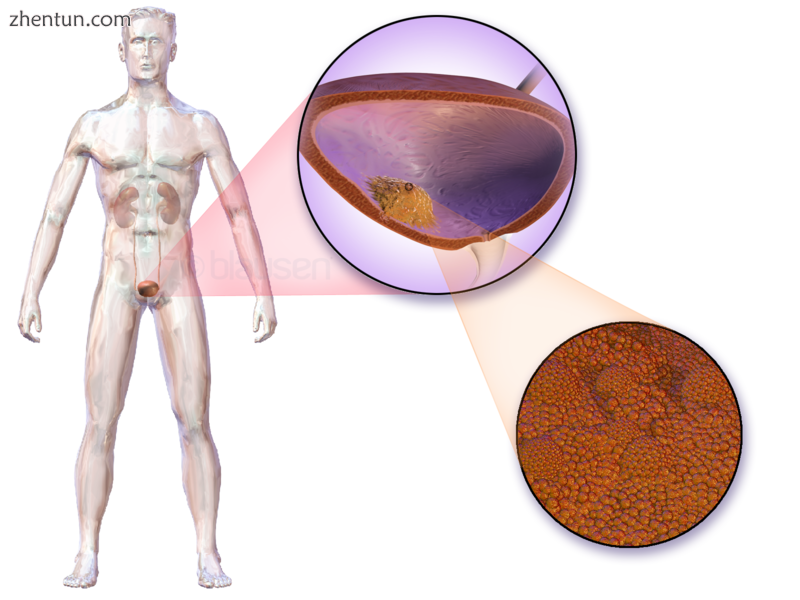
膀胱癌的位置
膀胱癌特征性地引起尿液中的血液(血尿),其可以是可见的(肉眼/肉眼可见的血尿)或仅通过显微镜(显微镜血尿)可检测到。尿液中的血液是膀胱癌中最常见的症状,并且是无痛的。尿液中的可见血液可能仅持续很短的时间,并且可能需要进行尿液检查以确认不可见的血液。 80-90%的膀胱癌患者最初出现可见血液[10]。尿液中的血液也可能由其他疾病引起,如膀胱或输尿管结石,感染,肾脏疾病,肾癌或血管畸形,但这些情况(肾癌除外)通常会很痛。
其他可能的症状包括排尿时疼痛(排尿困难),尿频,或感觉需要排尿而不能这样做。这些体征和症状不是膀胱癌特异性的,也可能是由非癌症引起的,包括前列腺感染,膀胱过度活动症或膀胱炎。
患有晚期疾病的患者是指骨盆或骨性疼痛,下肢肿胀或侧腹疼痛。很少,体检时可以检测到可触及的肿块。
原因
吸烟是导致膀胱癌的主要原因;在大多数人群中,吸烟与男性中超过一半的膀胱癌病例和女性中三分之一的病例相关[11],然而近年来这些比例已经降低,因为欧洲和北美的吸烟者较少。[12]吸烟持续时间(以年为单位),包年数与膀胱癌风险之间存在近似线性关系。可以观察到每天吸烟约15支香烟的风险平台(意味着每天吸15支烟的人与每天吸30支烟的风险大致相同)。戒烟降低了风险,但与不吸烟者相比,前吸烟者最有可能总是患膀胱癌的风险更高。[12]被动吸烟似乎不存在风险。[13]
百分之三十的膀胱肿瘤可能是由于工作场所职业接触致癌物质如联苯胺所致。在香烟烟雾中发现的2-萘胺也被证明会增加膀胱癌的风险。面临危险的职业是公交车司机,橡胶工人,汽车修理工,皮革(包括鞋)工人,铁匠,机器制造商和机械师。[14]由于经常暴露于永久性染发剂,理发师也被认为处于危险之中。
除了这些主要风险因素外,还有许多其他可改变的因素与膀胱癌相关性较弱(即风险增加10-20%),例如肥胖。[15] 虽然这些可被视为次要影响,但仍可通过将一些较小的风险因素的普遍程度降低来实现一般人群的风险降低。[16]
有人提出HRAS,KRAS2,RB1和FGFR3的突变可能在某些情况下有关[17]。
诊断
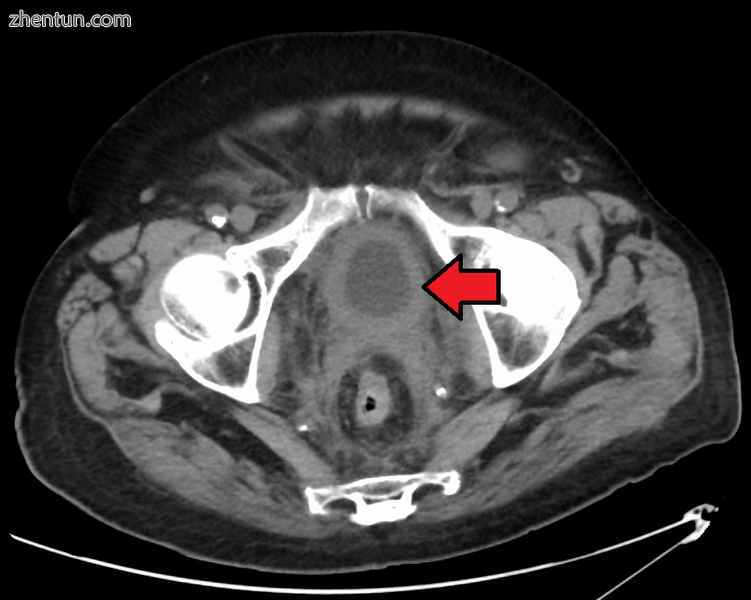
膀胱壁由于癌症而增厚
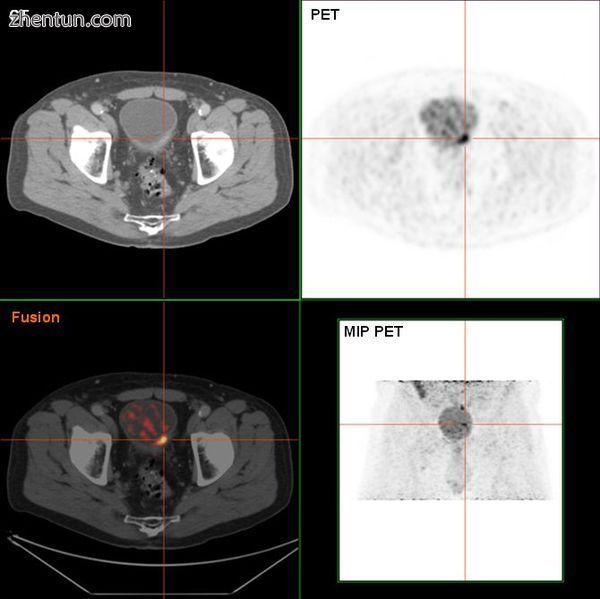
FDG PET中的膀胱肿瘤由于膀胱中的高生理FDG浓度,呋塞米与200MBq FDG一起供应。病变的颅骨摄取是结肠中的生理摄取。
目前,膀胱状态的最佳诊断是通过膀胱镜检查,这是一种通过尿道将带有照相机和各种器械的柔性管引入膀胱的过程。该程序允许目视检查膀胱,进行较小的补救工作以及进行活组织检查的可疑病变样本。
尿液细胞学可以在排尿尿液中或在膀胱镜检查时(“膀胱洗涤”)获得。细胞学不是很敏感(阴性结果不能可靠地排除膀胱癌)。[18]有更新的非侵入性尿液结合标志物可用于诊断膀胱癌,包括人补体因子H相关蛋白,高分子量癌胚抗原和核基质蛋白22(NMP22)。[19] NMP22也可作为处方家庭测试。其他基于非侵入性尿液的测试包括CertNDx膀胱癌测定,其结合FGFR3突变检测与蛋白质和DNA甲基化标记物来检测跨阶段和等级的癌症,UroVysion和Cxbladder。
膀胱癌的诊断也可以使用Hexvix / Cysview引导荧光膀胱镜检查(蓝光膀胱镜检查,光动力学诊断),作为常规白光膀胱镜检查的辅助手段。与单独的白光膀胱镜检查相比,该方法改善了膀胱癌的检测并降低了早期肿瘤复发的发生率。 Cysview膀胱镜检查发现更多癌症并减少复发。 Cysview在欧洲以Hexvix品牌销售。[20] [21] [22] [23]
然而,上面列出的任何形式的视觉检测不足以建立病理分类,细胞类型或本肿瘤的阶段。在普通膀胱镜检查(刚性或柔性)期间进行所谓的冷杯活检也不足以进行病理分期。因此,需要通过经尿道手术进行视觉检测。该过程称为经尿道膀胱肿瘤切除术(TURBT)。此外,应在TURBT之前和之后进行双手检查,以评估是否有可触及肿块或肿瘤是否固定(“拴住”)到骨盆壁。通过TURBT程序获得的病理分类对于随后的治疗和/或随访程序的适当选择具有根本重要性。[24]
病理分类
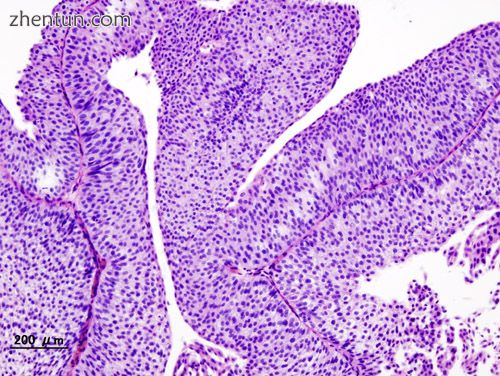
膀胱尿路上皮癌的组织病理学。 经尿道活检。 H&E染色。
95%的膀胱癌是移行细胞癌。 另外5%是鳞状细胞癌,腺癌,肉瘤,小细胞癌和体内其他癌症的继发性沉积物。[25]
原位癌(CIS)总是由细胞学上高等级的肿瘤细胞组成。[引证需要]
分期
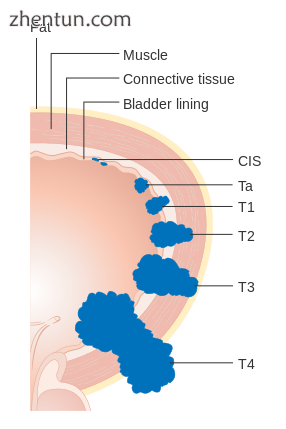
图显示膀胱癌的T阶段
膀胱癌分期(根据癌症的扩散程度分类)和分级(细胞在显微镜下出现异常和侵略性)以确定治疗和估计结果。
在TNM膀胱癌分期系统中,以下适用:[26]
T(原发肿瘤)
TX原发肿瘤无法评估
T0没有原发肿瘤的证据
Ta非侵袭性乳头状癌
原位癌('扁平肿瘤')
T1肿瘤侵入上皮下结缔组织
T2a肿瘤侵犯浅表肌肉(内半部)
T2b肿瘤侵入深部肌肉(外半部)
T3肿瘤侵犯有创性组织:
T3a在显微镜下观察
T3b肉眼观察(外周质量)
T4a肿瘤侵犯前列腺,子宫或阴道
T4b肿瘤侵犯骨盆壁或腹壁
N(淋巴结)
NX区域淋巴结无法评估
N0无区域淋巴结转移
N1在最大尺寸2cm或更小的单个淋巴结中转移
N2转移单个淋巴结超过2厘米但最大不超过5厘米,或多个淋巴结,最大尺寸不超过5厘米
N3淋巴结转移最大尺寸超过5厘米
M(远处转移)
MX远期转移无法评估
M0无远处转移
M1远处转移。
美国5年生存[27]
0 98%
I 88%
II 63%
III 46%
IV 15%
数字
上述阶段可以整合到数字分期(罗马数字)如下:[28]
阶段0a:Ta,N0,M0
阶段0:Tis,N0,M0
第1阶段:T1,N0,M0
阶段II:T2a或T2b,N0,M0
阶段III:T3a,T3b或T4a,N0,M0
第4阶段; 以下任何一项:
T4b,N0,M0
任何T,N1到N3,M0
任何T,任何N,M1
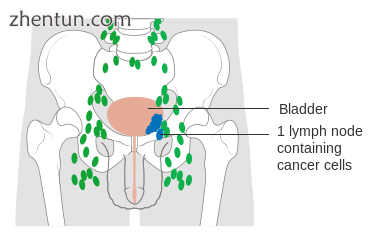
N1期膀胱癌
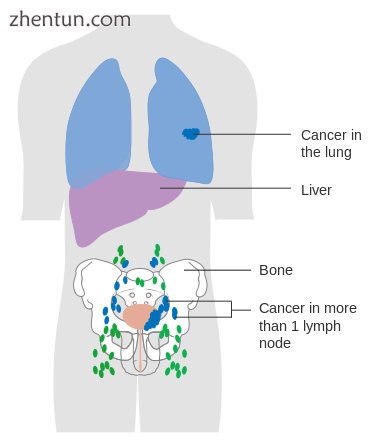
晚期膀胱癌
等级
根据世界卫生组织1973年的分类,膀胱癌在组织学上被分为:[29]
G1 - 分化良好,
G2 - 中度分化
G3 - 分化差
筛选
截至2010年,没有足够的证据来确定没有症状的人筛查膀胱癌是否有效。[30]
2013年,一项针对98例尿液的初步小型研究,均来自男性--24名患有癌症的患者,74名患有膀胱相关问题但未患癌症但仍使用气相色谱仪成功检查加热尿样中的蒸气以识别癌症。[31]
预防
由世界卫生组织委托进行的2008年一项研究得出结论,“特定的水果和蔬菜可能会降低患膀胱癌的风险。”[32]水果和黄橙色蔬菜,特别是胡萝卜和含有硒的蔬菜,[33]可能与中度降低膀胱癌风险。柑橘类水果和十字花科蔬菜也被确定为具有可能的保护作用。然而,对卫生专业人员随访研究中47,909名男性的分析显示,癌症减少与整体水果和蔬菜的高消费,或黄色或绿叶蔬菜的特别相关,与那些大量消费的男性的统计显着减少相比十字花科蔬菜。
在一项涉及近49,000名男性的10年研究中,研究人员发现,与饮酒较少的男性相比,每天饮用至少1,44升水(约6杯)的男性患膀胱癌的几率明显降低。还发现:“每增加240毫升液体,膀胱癌的风险就会降低7%”。[34]作者提出,膀胱癌可能部分是由于膀胱直接接触尿液中排出的致癌物质引起的,尽管这在其他研究中尚未得到证实。[32]
治疗
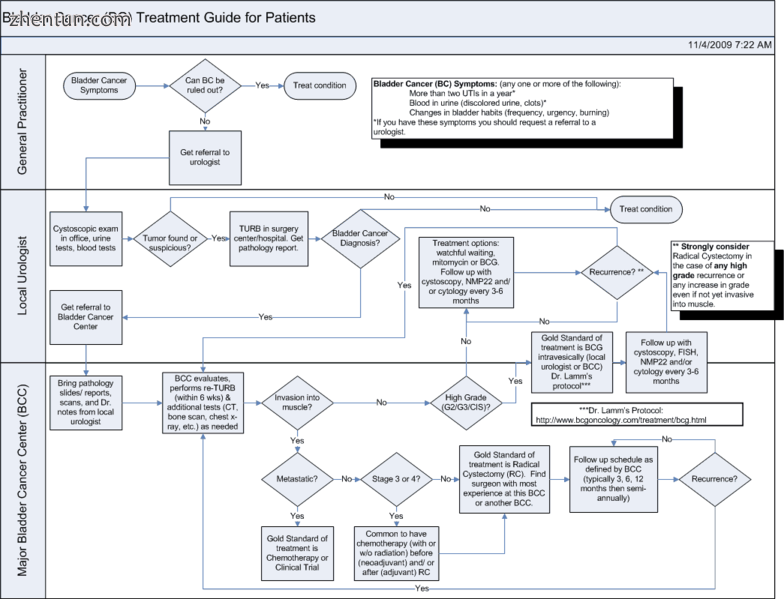
膀胱癌治疗指南的流程图
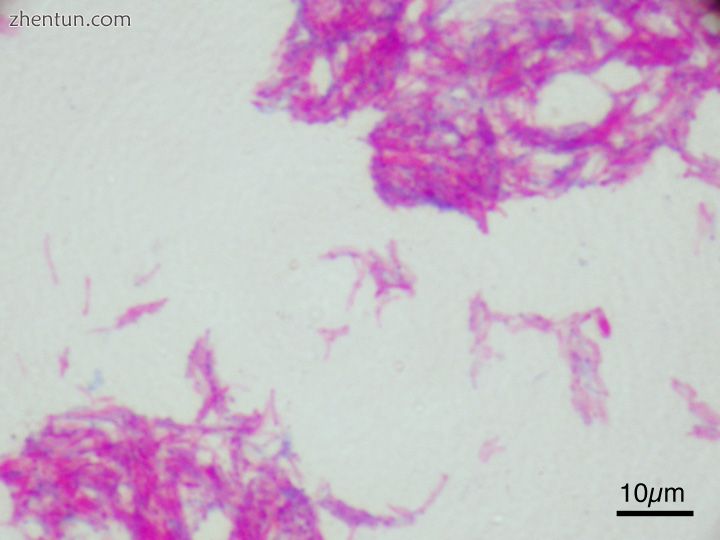
牛分枝杆菌的减毒株用于治疗膀胱癌
膀胱癌的治疗取决于肿瘤侵入膀胱壁的深度。
浅表肿瘤
表面肿瘤(未进入肌肉层的肿瘤)可以使用连接到膀胱镜的电灼装置“剃掉”,在这种情况下称为电切镜。该过程称为经尿道膀胱肿瘤切除术-TURBT-主要用于病理分期。在非肌肉浸润性膀胱癌的情况下,TURBT本身就是治疗,但在肌肉浸润性癌症的情况下,该程序不足以进行最终治疗。[24]
通过囊内递送卡介苗(BCG)进行免疫治疗也可用于治疗和预防浅表肿瘤的复发[35]。 BCG是一种针对结核病的疫苗,由减毒(弱化)活牛结核杆菌牛分枝杆菌(Mycobacterium bovis)制备,其在人体中丧失了毒力。在这个阶段,BCG免疫疗法在多达2/3的病例中有效,并且随机试验显示优于标准化疗。[36] BCG预防复发的机制尚不清楚,但膀胱中细菌的存在可能引发局部免疫反应,从而清除残留的癌细胞。[37]
用BCG治疗后肿瘤复发的患者更难治疗。[38]许多医生建议对这些患者进行膀胱切除术。该建议符合欧洲泌尿科医师协会(EAU)[39]和美国泌尿学会(AUA)[40]的官方指南。但是,许多患者拒绝接受这种改变生活的手术,并且更愿意尝试新颖保守选择最后一个激进的度假胜地之前的治疗方案。器械辅助化疗是用于治疗浅表性膀胱癌的一组新技术。[41]这些技术使用不同的机制来促进直接注入膀胱的化疗药物的吸收和作用。另一项技术 - 电动药物管理(EMDA) - 在手术切除肿瘤后使用电流来增强药物吸收[42] [43]。另一项技术,即热疗,利用射频能量直接加热膀胱壁,与化学疗法一起显示出协同效应,增强了彼此杀死肿瘤细胞的能力。许多不同的研究者已经研究了这项技术。[44] [45] [46] [47]
肌肉浸润性疾病
未经治疗的浅表肿瘤可逐渐开始渗入膀胱肌壁。渗入膀胱壁的肿瘤需要更多的根治性手术,其中部分或全部膀胱被切除(膀胱切除术)并且尿流被转移到孤立的肠环(称为回肠导管或尿道造口术)中。在一些情况下,熟练的外科医生可以从肠组织的一部分产生替代膀胱(新膀胱),但这在很大程度上取决于患者偏好,患者年龄,肾功能和疾病部位。
为了治疗侵入性肿瘤,可以使用放射和化学疗法的组合以及经尿道(内窥镜)膀胱肿瘤切除术。对这种所谓的三联疗法的现有大数据系列的回顾表明,类似的长期癌症特异性存活率,与改善尿路膀胱切除术的患者的整体生活质量有关。这些患者通常被高度选择,并且没有多灶性疾病或原位癌,这与膀胱癌复发,进展和死亡率高于接受根治性膀胱切除术的患者有关[48]。
光动力学诊断可以改善膀胱癌的手术效果。[49]
对于肌肉浸润性尿路上皮性膀胱癌,有许多治疗选择。如上所述,最好的方法是根治性膀胱切除术。在男性中,这通常还包括去除前列腺;在女性中,它涉及切除卵巢,子宫和部分阴道。
微转移疾病
为了解决微转移问题本身对长期存活有影响的问题,迫切需要新的治疗方案。仅通过大手术治疗微转移性传播通常是不可治疗的,并且新辅助化疗的概念已经发展。在该患者中,首先在3或4个周期内接受化疗,然后进行大手术。在世界范围内随机前瞻性试验的一些荟萃分析中,结果显示,在5年的随访时间内,该疗法的生存率为5-8%[50] [51] [52] [53]。
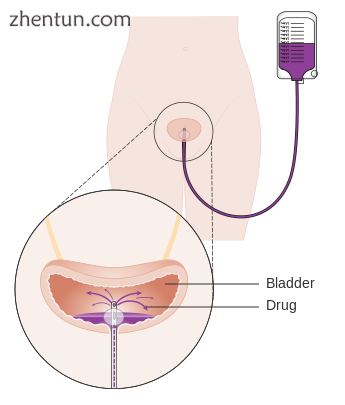
药物治疗(化疗)进入膀胱
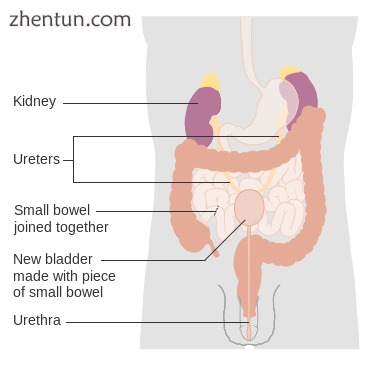
移除后膀胱的手术重建。
流行病学
2004年每10万居民患膀胱癌的年龄标准化死亡。[54]
![Age-standardized death from bladder cancer per 100,000 inhabitants in 2004.[54].jpg Age-standardized death from bladder cancer per 100,000 inhabitants in 2004.[54].jpg](data/attachment/forum/201812/17/142147ms8xxxxoi5oszsui.jpg)
全世界
在全球范围内,2010年,膀胱癌导致170,000人死亡,而1990年为114,000人。[55] 根据世界总人口的增长情况调整后增长了19.4%。
美国
在美国,膀胱癌是男性中第四种最常见的癌症类型,也是女性中第九位最常见的癌症。 每年有超过50,000名男性和16,000名女性被诊断患有膀胱癌。 吸烟只能部分解释男性发病率较高的情况。[56] 另一个原因是雄激素受体在男性中比在女性中更活跃,在癌症的发展中起着重要作用。[57]
英国
膀胱癌是英国第七大常见癌症(2011年约有10,400人被诊断患有该病),并且是癌症死亡的第七大常见原因(2012年约有5,200人死亡)。[58]
另见
Timeline of bladder cancer
参考
"Bladder Cancer Treatment". National Cancer Institute. Archived from the original on 14 July 2017. Retrieved 18 July 2017.
"Cancer of the Urinary Bladder – Cancer Stat Facts". seer.cancer.gov. Archived from the original on 8 July 2017. Retrieved 18 July 2017.
"Bladder Cancer". National Cancer Institute. Archived from the original on 17 July 2017. Retrieved 18 July 2017.
"Bladder Cancer Treatment". National Cancer Institute. 5 June 2017. Archived from the original on 14 July 2017. Retrieved 18 July 2017.
GBD 2015 Disease and Injury Incidence and Prevalence, Collaborators. (8 October 2016). "Global, regional, and national incidence, prevalence, and years lived with disability for 310 diseases and injuries, 1990–2015: a systematic analysis for the Global Burden of Disease Study 2015". Lancet. 388 (10053): 1545–1602. doi:10.1016/S0140-6736(16)31678-6. PMC 5055577. PMID 27733282.
GBD 2015 Mortality and Causes of Death, Collaborators. (8 October 2016). "Global, regional, and national life expectancy, all-cause mortality, and cause-specific mortality for 249 causes of death, 1980–2015: a systematic analysis for the Global Burden of Disease Study 2015". Lancet. 388 (10053): 1459–1544. doi:10.1016/s0140-6736(16)31012-1. PMC 5388903. PMID 27733281.
"Cancer Fact sheet N°297". World Health Organization. February 2014. Archived from the original on 29 December 2010. Retrieved 10 June 2014.
"Defining Cancer". National Cancer Institute. Archived from the original on 25 June 2014. Retrieved 10 June 2014.
World Cancer Report 2014. World Health Organization. 2014. pp. Chapter 1.1. ISBN 9283204298.
"Diagnosis and Management of Hematuria". Surgical Clinics of North America. 96 (3): 503–515. 2016-06-01. doi:10.1016/j.suc.2016.02.007. ISSN 0039-6109.
Zeegers MP; Tan, FE; Dorant, E; Van Den Brandt, PA (2000). "The impact of characteristics of cigarette smoking on urinary tract cancer risk: a meta-analysis of epidemiologic studies". Cancer. 89 (3): 630–9. doi:10.1002/1097-0142(20000801)89:3<630::AID-CNCR19>3.0.CO;2-Q. PMID 10931463.
Osch, Frits H. M. van; Jochems, Sylvia H. J.; Schooten, Frederik-Jan van; Bryan, Richard T.; Zeegers, Maurice P. (2016-04-20). "Quantified relations between exposure to tobacco smoking and bladder cancer risk: a meta-analysis of 89 observational studies". International Journal of Epidemiology: dyw044. doi:10.1093/ije/dyw044. ISSN 0300-5771. PMID 27097748.
Lee, PN; Thornton, AJ; Hamling, JS (October 2016). "Epidemiological evidence on environmental tobacco smoke and cancers other than lung or breast". Regulatory toxicology and pharmacology. 80: 134–63. doi:10.1016/j.yrtph.2016.06.012. PMID 27321059.
Reulen RC, Zeegers MP (September 2008). "A meta-analysis on the association between bladder cancer and occupation". Scandinavian journal of urology and nephrology. Supplementum. 42 (218): 64–78. doi:10.1080/03008880802325192. PMID 18815919.
Sun, Jiang-Wei; Zhao, Long-Gang; Yang, Yang; Ma, Xiao; Wang, Ying-Ying; Xiang, Yong-Bing (24 March 2015). "Obesity and Risk of Bladder Cancer: A Dose-Response Meta-Analysis of 15 Cohort Studies". PLOS ONE. 10 (3): e0119313. doi:10.1371/journal.pone.0119313. ISSN 1932-6203. PMC 4372289. PMID 25803438. Archived from the original on 5 March 2017.
Al-Zalabani, AbdulmohsenH.; Stewart, KellyF.J.; Wesselius, Anke; Schols, AnnemieM.W.J.; Zeegers, MauriceP. (2016-03-21). "Modifiable risk factors for the prevention of bladder cancer: a systematic review of meta-analyses". European Journal of Epidemiology: 1–41. doi:10.1007/s10654-016-0138-6. ISSN 0393-2990. PMC 5010611.
Online Mendelian Inheritance in Man (OMIM) 109800
Lotan, Y.; Roehrborn, C. G. (2003). "Sensitivity and specificity of commonly available bladder tumor markers versus cytology: Results of a comprehensive literature review and meta-analyses". Urology. 61 (1): 109–118, discussion 118. doi:10.1016/S0090-4295(02)02136-2. PMID 12559279.
Shariat; Karam, JA; Lotan, Y; Karakiewizc, PI; et al. (2008). "Critical Evaluation of Urinary Markers for Bladder Cancer Detection and Monitoring". Reviews in Urology. 10 (2): 120–135. PMC 2483317. PMID 18660854.
"Hexvix". Archived from the original on 21 October 2013.
"Photocure—Cysview Hexaminolevulinate (HCL)". Cysview.net. Archived from the original on 27 January 2013. Retrieved 10 January 2013.
"Archived copy". Archived from the original on 31 March 2012. Retrieved 22 April 2011. Fluorescence-guided transurethral resection of bladder tumours reduces bladder tumour recurrence due to less residual tumour tissue in Ta/T1 patients
"Hexvix guided fluorescence cystoscopy reduces recurrence in patients". Archived from the original on 24 July 2011.
"European Association of Urology (EAU)—Guidelines—Online Guidelines". Uroweb.org. Archived from the original on 28 January 2013. Retrieved 10 January 2013.
"Types of Bladder Cancer: TCC & Other Variants | CTCA". CancerCenter.com. Retrieved 2018-08-10.
Longe, Jacqueline L. (2005). Gale Encyclopedia Of Cancer: A Guide To Cancer And Its Treatments. Detroit: Thomson Gale. p. 137. ISBN 978-1-4144-0362-5.
"Survival rates for bladder cancer by stage". American Cancer Society. Archived from the original on 13 October 2015. Last Medical Review: 02/26/2014
"How is bladder cancer staged?". American Cancer Society. Archived from the original on 4 October 2015. Last Medical Review: 02/26/2014
Seth P. Lerner. "Overview of Diagnosis and Management of Non-Muscle Invasive Bladder Cancer" (PDF). Food and Drug Administration. ODAC September 14, 2016
Chou R, Dana T (October 2010). "Screening adults for bladder cancer: a review of the evidence for the U.S. preventive services task force". Ann. Intern. Med. 153 (7): 461–8. doi:10.7326/0003-4819-153-7-201010050-00009. PMID 20921545.
Roberts, Michelle; online (9 July 2013). "Urine odour test for bladder cancer". BBC News. BBC News. Archived from the original on 30 June 2016. Retrieved 19 June 2016.
Brinkman M, Zeegers MP (September 2008). "Nutrition, total fluid and bladder cancer". Scandinavian Journal of Urology and Nephrology. Supplementum. 42 (218): 25–36. doi:10.1080/03008880802285073. PMID 18815914.
Brinkman M, Zeegers MP (2006). "Use of selenium in chemoprevention of bladder cancer". Lancet Oncol. 7 (9): 766–74. doi:10.1016/S1470-2045(06)70862-2. PMID 16945772.
Valtin H (November 2002). ""Drink at least eight glasses of water a day." Really? Is there scientific evidence for "8 × 8"?". American Journal of Physiology. 283 (5): R993–R1004. doi:10.1152/ajpregu.00365.2002. PMID 12376390. Archived from the original on 4 February 2015.
Alexandroff AB, Jackson AM, O'Donnell MA, James K (May 1999). "BCG immunotherapy of bladder cancer: 20 years on". Lancet. 353 (9165): 1689–94. doi:10.1016/S0140-6736(98)07422-4. PMID 10335805.
Lamm, Donald L.; Blumenstein, Brent A.; Crawford, E. David; Montie, James E.; Scardino, Peter; Grossman, H. Barton; Stanisic, Thomas H.; Smith Jr, Joseph A.; Sullivan, Jerry; Sarosdy, Michael F.; Crissman, John D.; Coltman, Charles A. (1991). "A Randomized Trial of Intravesical Doxorubicin and Immunotherapy with Bacille Calmette–Guérin for Transitional-Cell Carcinoma of the Bladder". New England Journal of Medicine. 325 (17): 1205–9. doi:10.1056/NEJM199110243251703. PMID 1922207.
"Bladder Cancer Stages, Prognosis, Diagnosis, and Treatment". Archived from the original on 11 October 2013.
Witjes JA (May 2006). "Management of BCG failures in superficial bladder cancer: a review". European Urology. 49 (5): 790–7. doi:10.1016/j.eururo.2006.01.017. PMID 16464532.
Babjuk W, Oosterlinck W, Sylvester R, et al. (2010). "Guidelines on TaT1 (Non-muscle invasive) Bladder Cancer". European Association of Urology. Archived from the original on 24 April 2010.
Bladder Cancer Clinical Guideline Update Panel (2007). Bladder Cancer: Guideline for the Management of Nonmuscle Invasive Bladder Cancer: (Stages Ta, T1, and Tis): 2007 Update. American Urological Association.[page needed]
Witjes JA, Hendricksen K (January 2008). "Intravesical pharmacotherapy for non-muscle-invasive bladder cancer: a critical analysis of currently available drugs, treatment schedules, and long-term results". European Urology. 53 (1): 45–52. doi:10.1016/j.eururo.2007.08.015. PMID 17719169.
Di Stasi SM, Riedl C (June 2009). "Updates in intravesical electromotive drug administration of mitomycin-C for non-muscle invasive bladder cancer". World Journal of Urology. 27 (3): 325–30. doi:10.1007/s00345-009-0389-x. PMID 19234707.
Kos, Bor; Vásquez, Juan Luis; Miklavčič, Damijan; Hermann, Gregers G G; Gehl, Julie (2016). "Investigation of the mechanisms of action behind Electromotive Drug Administration (EMDA)". PeerJ. 4 (e2309). doi:10.7717/peerj.2309. PMC 5012313. PMID 27635313. Archived from the original on 9 October 2016. Retrieved 24 August 2016.
Nativ O, Witjes JA, Hendricksen K, et al. (October 2009). "Combined thermo-chemotherapy for recurrent bladder cancer after bacillus Calmette-Guerin". The Journal of Urology. 182 (4): 1313–7. doi:10.1016/j.juro.2009.06.017. PMID 19683278.
Colombo R, Da Pozzo LF, Salonia A, et al. (December 2003). "Multicentric study comparing intravesical chemotherapy alone and with local microwave hyperthermia for prophylaxis of recurrence of superficial transitional cell carcinoma". Journal of Clinical Oncology. 21 (23): 4270–6. doi:10.1200/JCO.2003.01.089. PMID 14581436.
Alfred Witjes J, Hendricksen K, Gofrit O, Risi O, Nativ O (June 2009). "Intravesical hyperthermia and mitomycin-C for carcinoma in situ of the urinary bladder: experience of the European Synergo working party". World Journal of Urology. 27 (3): 319–24. doi:10.1007/s00345-009-0384-2. PMC 2694311. PMID 19234857.
Halachmi S, Moskovitz B, Maffezzini M, et al. (April 2009). "Intravesical mitomycin C combined with hyperthermia for patients with T1G3 transitional cell carcinoma of the bladder". Urologic Oncology. 29 (3): 259–264. doi:10.1016/j.urolonc.2009.02.012. PMID 19395285.
Smelser WW, Austenfeld MA, Holzbeierlein JM, Lee EK. Where are we with bladder preservation for muscle-invasive bladder cancer in 2017?. Indian J Urol 2017;33:111-7 http://www.indianjurol.com/text.asp?2017/33/2/111/203415 Archived 10 September 2017 at the Wayback Machine.
O'Brien T, Thomas K (November 2010). "Bladder cancer: Photodynamic diagnosis can improve surgical outcome". Nature Reviews Urology. 7 (11): 598–9. doi:10.1038/nrurol.2010.183. PMID 21068759.
Advanced Bladder Cancer (ABC) Meta-analysis Collaboration (August 2005). "Neoadjuvant chemotherapy in invasive bladder cancer: update of a systematic review and meta-analysis of individual patient data advanced bladder cancer (ABC) meta-analysis collaboration". Eur. Urol. 48 (2): 202–5, discussion 205–6. doi:10.1016/j.eururo.2005.04.006. PMID 15939524.
Grossman HB, Natale RB, Tangen CM, et al. (August 2003). "Neoadjuvant chemotherapy plus cystectomy compared with cystectomy alone for locally advanced bladder cancer". N. Engl. J. Med. 349 (9): 859–66. doi:10.1056/NEJMoa022148. PMID 12944571.
Hall R. Updated results of a randomised controlled trial of neoadjuvant cisplatin (C), methotrexate (m) and vinblastin (V) chemotherapy for muscle-invasive bladder cancer. Proc Am Soc Clin Oncol 2002;21:178A, abstr 710.
Sherif A, Holmberg L, Rintala E, et al. (March 2004). "Neoadjuvant cisplatinum based combination chemotherapy in patients with invasive bladder cancer: a combined analysis of two Nordic studies". Eur. Urol. 45 (3): 297–303. doi:10.1016/j.eururo.2003.09.019. PMID 15036674.
"WHO Disease and injury country estimates". World Health Organization. 2009. Archived from the original on 11 November 2009. Retrieved 11 November 2009.
Lozano, R; et al. (15 December 2012). "Global and regional mortality from 235 causes of death for 20 age groups in 1990 and 2010: a systematic analysis for the Global Burden of Disease Study 2010". Lancet. 380 (9859): 2095–128. doi:10.1016/S0140-6736(12)61728-0. PMID 23245604.
Hemelt M, Zeegers MP (2000). "The effect of smoking on the male excess of bladder cancer: a meta-analysis and geographical analyses". Int J Cancer. 124 (2): 412–9. doi:10.1002/ijc.23856. PMID 18792102.
"Scientists Find One Reason Why Bladder Cancer Hits More Men". University of Rochester Medical Center. 20 April 2007. Archived from the original on 11 January 2009. Retrieved 20 April 2007.
"Bladder cancer statistics". Cancer Research UK. Archived from the original on 17 October 2014. |